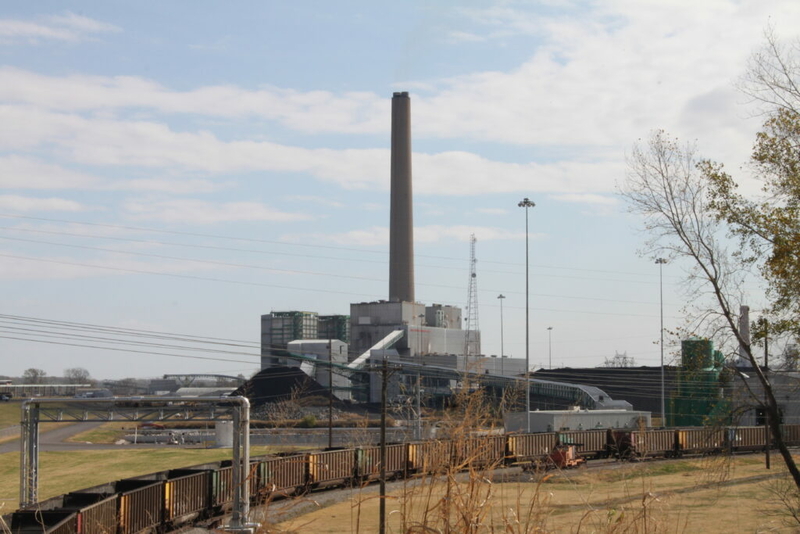Sulfur dioxide pollution in the Bootheel breaks EPA rules. Regulators look to fix it

A coal-fired power plant must cut emissions and an aluminum smelter must spend millions to rid a community in Missouri’s Bootheel of sulfur dioxide pollution by 2026 under a deal with state environmental regulators.
Part of New Madrid County is out of compliance with Environmental Protection Agency standards for having triple the limit of sulfur dioxide in its air. The compound, which is a component of acid rain, can exacerbate breathing and heart issues.
“It’s pretty far in excess,” said Mark Leath, the air quality planning section chief for the Missouri Department of Natural Resources. He added that the concentration has gone up in recent years after the aluminum smelter restarted operations.
“I think it’s like four or five times the level of the standard.”
The sources of the heightened sulfur dioxide, the regulators found, are the Magnitude 7 aluminum smelter in Marston and the adjacent New Madrid Power Plant, operated by Associated Electric Cooperative Inc., which supplies power to co-ops across Missouri.
The department is proposing a plan to bring sulfur dioxide concentrations down and will receive public comments Thursday at a Missouri Air Conservation Commission meeting.
Magnitude 7, which started operations in 2018 after its predecessor, Noranda Aluminum, filed for bankruptcy, will have to build a $7 million stack to better dissipate its sulfur dioxide emissions under a consent agreement with the state. And the power plant will have to rein in its own emissions.
A leading environmental group argues the requirements on the power plant aren’t enough.
“It’s unfortunate that DNR is not requiring meaningful sulfur dioxide pollution reductions at AECI’s coal plant, which emitted over 10,000 tons of (sulfur dioxide) in 2021,” said Brian Smith, Missouri’s organizing representative with the Sierra Club’s Beyond Coal Campaign.
Though the state’s plan has not yet been presented to the air commission, Leath said efforts to reduce sulfur dioxide concentrations are already underway.
Magnitude 7’s director of environmental health, safety and security, Art Nispel, said the smelter is working quickly to plan and build the 213-foot tower. He anticipates it will be built by the end of 2023.
Nispel said the cost of building the stack will be a strain on the plant, which nearly shut its doors in early 2020, according to Reuters. Magnitude 7 can’t raise its prices because aluminum values are set by the global market. Nispel said the plant had to lay off 30 or 40 workers because of low aluminum prices.
“Obviously it will reduce our income,” he said. “But that’s something that we’ve committed to do in order to continue operating and doing what we said we would do, which was from the very beginning, is protecting the environment along with making the metal.”
But the stack won’t eliminate the sulfur dioxide emissions. It will replace shorter existing stacks that release sulfur dioxide low enough that it gets trapped near the ground. A taller stack will allow the compound to dissipate.
At a public information meeting earlier this month, one resident asked if that would make the compound another community’s problem downwind.
But Nicole Weidenbenner, implementation plan unit chief for the state, said sulfur dioxide doesn’t typically travel far.
“So we are not expecting to kick the can down the road and just create a problem elsewhere but solve our local problem,” she said.
And Leath said if the plan the department has proposed doesn’t bring sulfur dioxide concentrations down enough, there is a contingency plan with further restrictions that will kick in automatically.
Nispel said Magnitude 7 is concerned about its workers breathing in sulfur dioxide and is “going forward as quickly as we can to put this project in to take care of the issues.”
Mark Viguet, managing director of corporate communications for Associated Electric Cooperative Inc., said in an email that no construction would be needed at the New Madrid Power Plant to meet the lower sulfur dioxide limit it agreed to under its consent decree with the state.
“While no additional costs are anticipated under the terms of the consent agreement, Associated Electric has made significant investments since the 1990s to comply with air regulations,” Viguet said. “During that time, more than $1 billion has been spent to significantly improve the air emissions at our power plants, including New Madrid.”
According to a fact sheet Viguet supplied, the company has cut sulfur dioxide emissions at its plants by 90% since the mid 1990s.
Its plants also emit a fraction of the nitrogen oxides, the other component of acid rain, that they did in 1994, according to the company.
The Missouri Air Conservation Commission will meet at 9 a.m. Thursday in Jefferson City and via WebEx. Residents who would like to listen or provide comments can find out more information on the Department of Natural Resources’ website: dnr.mo.gov/calendar.








